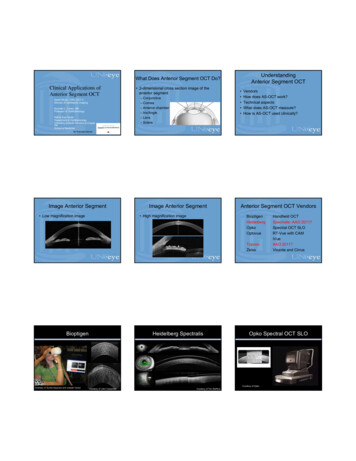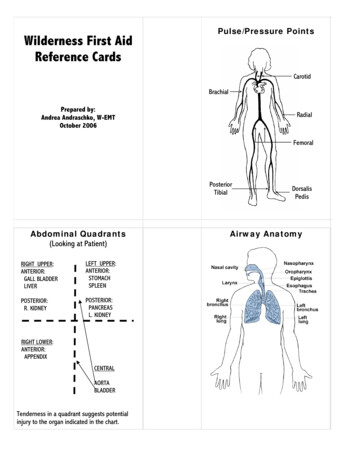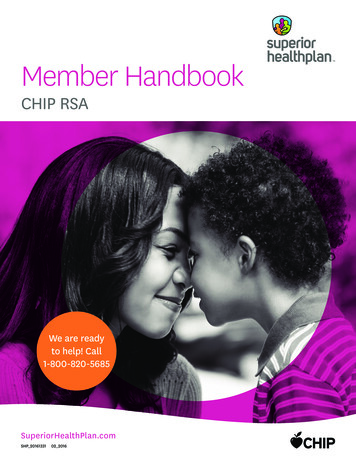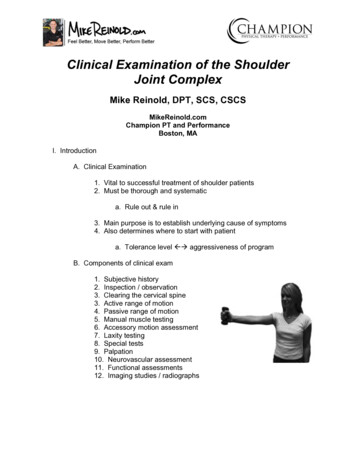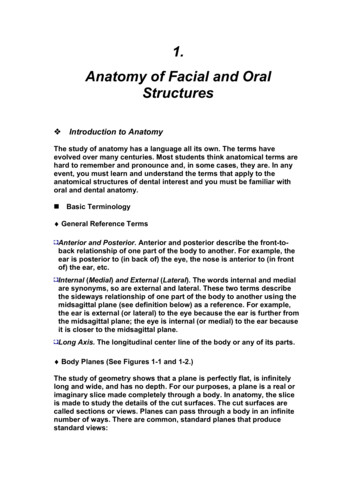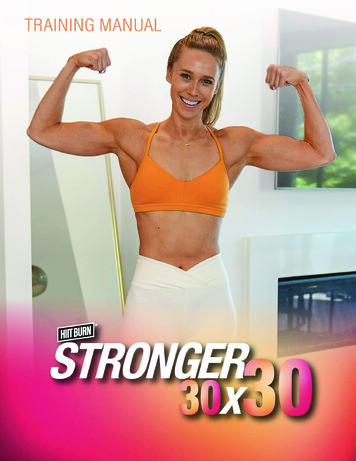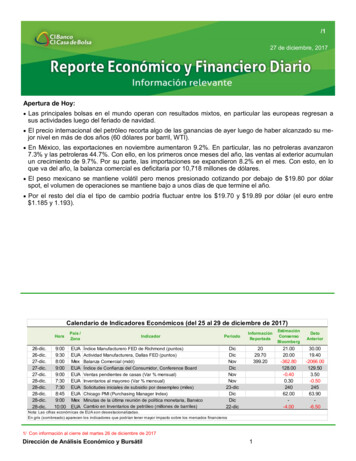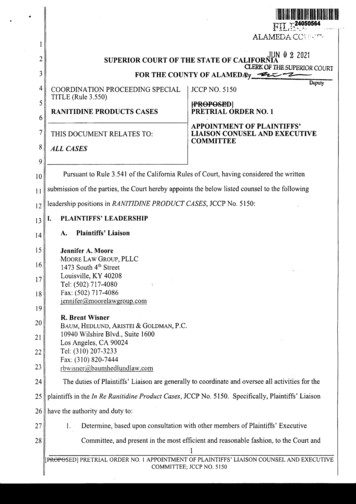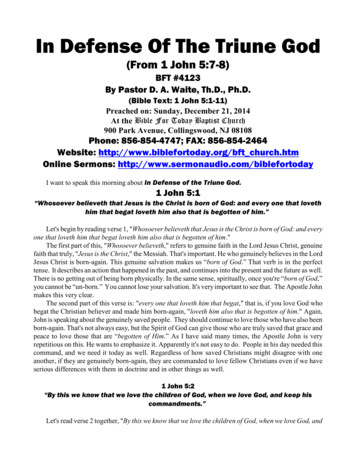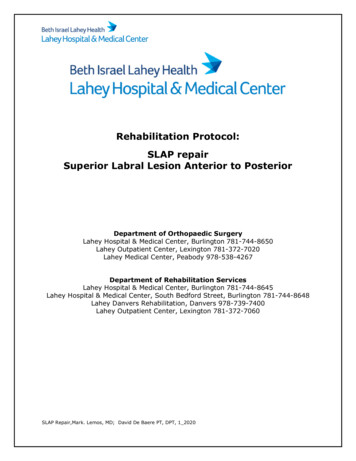
Transcription
Rehabilitation Protocol:SLAP repairSuperior Labral Lesion Anterior to PosteriorDepartment of Orthopaedic SurgeryLahey Hospital & Medical Center, Burlington 781-744-8650Lahey Outpatient Center, Lexington 781-372-7020Lahey Medical Center, Peabody 978-538-4267Department of Rehabilitation ServicesLahey Hospital & Medical Center, Burlington 781-744-8645Lahey Hospital & Medical Center, South Bedford Street, Burlington 781-744-8648Lahey Danvers Rehabilitation, Danvers 978-739-7400Lahey Outpatient Center, Lexington 781-372-7060SLAP Repair,Mark. Lemos, MD; David De Baere PT, DPT, 1 2020
Overview:The shoulder labrum is a fibrocartilaginous rim attached to the margin of theglenoid cavity. It deepens the cavity by approximately 50%. Approximately 40%of the long head of biceps tendon (LHBT) attaches to the labrum. A superiorlabrum anterior and posterior (SLAP) tear involves a tear in the 10 o’clock to 2o’clock positions on the glenoid and frequently involves the LHBT.A SLAP tear can be caused by an acute injury such as a fall onto an outstretchedarm, a shoulder dislocation or a motor vehicle accident or it may be due torepetitive overhead activities. Labral fraying is also part of the normal agingprocess.Surgical intervention may involve debridement or repair depending on the size ofthe tear, the mechanism of injury and the age of the patient. The LHBT may bereattached, or may have undergone a tenodesis or tenotomy.It is important for the therapist to work closely with the surgeon to understand thesurgical intervention, which will guide the rehabilitation process.11Burns, JP et al. Superior labral tears: repair versus biceps tenodesis J Shoulder Elbow Surg 2011 Mar;20(2 suppl): S2-8SLAP Repair,Mark. Lemos, MD; David De Baere PT, DPT, 1 20202
Phase I Protective Phase: 0 4 WeeksGoals: Protect anatomic repairAllow healing of repaired labrumInitiate early protected and restricted range of motionMinimize muscular atrophyDecrease pain/inflammationPromote dynamic stability Sling for 4 weeks during day and at nightNO active ER, extension or elevationNO isolated activation of bicepsNO jogging, running, jumpingNO long head bicep tension for 6 weeks to protect repaired tissues- avoidlong lever arm with shoulder flexionNO resisted supination or resisted elbow flexionNO early pendulumsPrecautions Weeks 0–2 Cryotherapy AROM C-spine, wrist and hand PROM elbow flexion, supination and pronation as toleratedPrecautions:Weeks 3 4 Continue cryotherapyPROM/AAROM:Flexion as toleratedAbduction to 80 ER in neutral as toleratedER/IR in scapular plane:ER: 30 IR: 60 Therapeutic ExerciseActive: Scapular retraction C-spine, wrist and hand Ball squeezes Scapular Rhythmic stabilization (RS) Walking, stationary bike wearing sling 3 Weeks: Sub-maximal isometric exercise at 0 abduction: Flexion Abduction IR/ER Overhead pulley/Wand AAROM 4 weeksD/C sling at 4 weeks unless advised by surgeonSLAP Repair,Mark. Lemos, MD; David De Baere PT, DPT, 1 20203
Phase II – Intermediate Phase (5-7 weeks after surgery)Goals Gradual increase in ROMImprove strengthDecrease pain/inflammationPromote dynamic stabilityPrecautions Gentle mid-range ER in scapular plane, gradually progress to ER inabductionAvoid resisted supination during ER to protect bicepsProgress active motion only when patient demonstratesscapulohumeral rhythmNo biceps strengthening until 6 weeksWeeks 5 7D/C Sling after 4 weeks unless advised by surgeonPROM AAROM AROM (with scapulohumeral rhythm) Continue AAROM overhead pulleys/wand Shoulder flexion as tolerated (initiate in supine) Abduction/Scaption as tolerated (initiate in sidelying) ER at 0 abduction as tolerated ER/IR in scapular plane:ER: 50 IR: 60 Gentle IR behind backTherapeutic Exercise Active-assisted progressing to active forward flexion and scaption withscapulohumeral rhythm Sidelying ER6 weeks Theraband IR/ER Latissimus strengthening below 90 elevation (never behind head) begin light and gradual ER at 90 abduction progressing to 45 ER Initiate AROM elbow Prone row Prone extension Prone T7 weeks Deloaded Scapular StabilizationSLAP Repair,Mark. Lemos, MD; David De Baere PT, DPT, 1 20204
Phase III Early Strengthening (8 12 Weeks after surgery)Goals Protect repairGradually restore full range of motionIncrease strengthImprove neuromuscular controlEnhance proprioception and kinesthesiaPrecautions Gentle mid-range ER in scapular plane, gradually progress to ER inabductionContinue to protect bicepsProgress only when patient demonstrates scapulohumeral rhythmGentle biceps strengthening onlyWeek 8-9: Gradually progress to Full ROM: G/H mobilization as neededFlexion to 180 ER to 90 at 90 abductionIR full at 90 abductionTherapeutic Exercise Sleeper stretch if posterior capsule tightness ER in scapular plane gradually progress to ER in abduction Wall slide IR behind back Horizontal adduction Sidelying IR at 90 flexion PNF patterns with tubingWeek 9-10: Hands behind head starts Theraband exercises:o Scapular Stab, ER, IR forward, punch, shrug, dynamic hug, “W”’sWeek 11-12: Seated row Dynamic exercises Continue phase II exercises Progressive Resistive Exercises 1-3 lb. as tolerated Prone Y Continue rhythmic stab Continue proprioception drills Scapulohumeral rhythm exercisesSLAP Repair,Mark. Lemos, MD; David De Baere PT, DPT, 1 20205
Phase IV (12-16 Weeks after surgery)Goals Full ROMImprove: strength, power and enduranceImprove neuromuscular controlImprove dynamic stabilityPrecautions NOT ready for return to sportsWeight training precautions: Never drop elbows below plane of body“Always see elbows”No lat pulls behind head Continue to avoid excessive or forceful extension and ERWeeks 12-16 Full ROM Continue previous stretchesTherapeutic Exercise Continue phase III exercises Progress bicep curls Plyometric exercises: Rebounder throws arm at side Wall dribbles overheadSLAP Repair,Mark. Lemos, MD; David De Baere PT, DPT, 1 20206
Phase V (16-20 Weeks after surgery)Goals Progressively increase activities to prepare patient forunrestricted functional returnPrecautions Weight training precautionsWeeks 16-20 Full ROMTherapeutic ExerciseContinue abovePlyometric Exercise: Add rebounder throws with decelerations Wall dribbles at 90 Wall dribble circlesInterval sports programs can begin per MD clearanceSLAP Repair,Mark. Lemos, MD; David De Baere PT, DPT, 1 20207
Rehabilitation Protocol for Superior Labral Lesion Anterior to Posterior: Summary TablePost –opPhase/GoalsPhase I0 - 4 weeks aftersurgeryRange ofMotionWeeks 0-2Therapeutic ExercisePrecautionsCryotherapyAROM C-spine, wrist and handPROM elbow flexion, supination and pronation astoleratedSling for 4 weeksduring day and atnightGoals:Protect anatomic repairAllow healing ofrepaired labrumInitiate early protectedandrestricted range ofmotionWeeks 3-4PROM/AAROM Active:Flexion as-Scapular retractiontolerated-C-spine, wrist and hand AROM-Ball squeezesAbduction to-Scapular Rhythmic stabilization (RS)80º-Walking, Stationary Bike wearing slingMinimize muscularatrophyER in neutral astoleratedDecreasepain/inflammationER/IR inscapular plane:ER: 30 ºIR : 60 ºPromote dynamicstability-Passive and Active-assisted ROM:3 weeks:-Sub maximal isometric exercise at0 of abduction: flexion, abd, IR & ER4 weeksOverhead pulley/Wand AAROMNO active ER,extension orelevationNO isolatedactivation of bicepsNO jogging, running,jumpingNO long head biceptension for 6 weeksto protect repairedtissues – avoid longlever arm withshoulder flexionNO resistedsupination andresisted elbow flexionNO early pendulumsSLAP Repair,Mark. Lemos, MD; David De Baere PT, DPT, 1 2020
Phase II5 to 7 weeks aftersurgeryGoals:Gradual increase in ROMImprove strengthDecreasepain/inflammationPromote dynamicstabilityFlexion astolerated(initiate insupine)Scaption as tol(initiate insidelying)Abduction as tol.(initiate insidelying)ER in neutral astol.ER/IR inscapular planeER: 50 ºIR : 60 ºD/C Sling at 4 weeks per surgeonclearanceContinue Phase I exercisesPROM AAROM AROM (with scapulohumeralrhythm)Sidelying ERContinue AAROM overhead pulleys/wandShoulder flexion as tolerated (initiate insupine)Abduction/Scaption as tolerated (initiatein sidelying)ER at 0 abduction as toleratedGentle IR behind back6 weeksProne: row, extension, “T”Theraband IR/ERAt 6 weeksLatissimus strengthening below 90º elevationbeginlight and gradual (never behind head)Begin light and gradual ER at 90 abductionER at 90ºprogressing to 45 ERabductionInitiate AROM elbowprogressing to45º ER7 weeksDeloaded Scapular StabilizationSLAP Repair,Mark. Lemos, MD; David. De Baere PT, DPT, 1 2020Gentle mid-rangeER in scapularplane,gradually progressto ER in abductionDo not allow pt tosupinate during ERto protect bicepsProgress only whenpatientdemonstratesscapulohumeralrhythmNO bicepsstrengthening until6 weeks9
Phase III8-12 weeks aftersurgeryGoals:Gradually restorefull range of motionIncrease eption andkinesthesiaGradually progress tofull ROM:Flexion to 180 ºER to 90º at 90º abdIR full at 90º abdG/H Joint mobilization as needed to progressROMSleeper stretch if posterior capsule tightnessER in scapular planeWall slideIR behind backHorizontal adductionSidelying IR at 90º flexionPNF patterns with tubingWeek 9:Hands behind head startsTheraband exercises:-Scapular Stab, ER, IR, forward, punch, shrug,dynamic hug, ‘W’sWeek 11:-Seated row-Dynamic exercises:-Continue phase II exercises-PRE 1-3 lb. as tolerated-Prone Y-Continue Rhythmic Stab-Continue proprioception drills-Scapulohumeral rhythm exercisesSLAP Repair,Mark. Lemos, MD; David. De Baere PT, DPT, 1 2020Gentle mid-rangeER in scapularplane, graduallyprogress to ER inabductionContinue to protectbicepsProgress only whenpatientdemonstratesscapulohumeralrhythmGentle bicepsstrengthening only10
Phase IV12- 16 weeks aftersurgeryGoals:Full ROMImprove: strength,power andenduranceImproveneuromuscularcontrolImprove dynamicstabilityFull ROMContinueprevious stretchesPhase V16-20 weeks aftersurgeryGoals:Progressivelyincreaseactivities to preparepatient forunrestrictedfunctional returnFull ROM-Continue phase III exercises-Plyometric exercises:-Rebounder throws arm at sideWall dribbles overheadWeek 12-Progress biceps curls-Continue above-Plyometric exercise:-Add rebounder throws with-Decelerations-wall dribbles at 90º,-wall dribble circlesNot ready forreturn to sportsWeight trainingprecautions:Never drop elbowsbelow plane of body“Always seeelbows”No Lat pulls behindheadContinue to avoidexcessive orforceful extensionand ERWeight trainingprecautionsInterval sports programs can begin per MDAAROM active-assisted range of motion, ADL activity of daily living, AROM active range of motion, PROM passive range of motion, ER external rotation, IR internal rotation,ROM Range of Motion G/H glenohumeralSLAP Repair,Mark. Lemos, MD; David. De Baere PT, DPT, 1 202011
Allow healing of repaired labrum PROM/AAROM Flexion as Initiate early protected and restricted range of motion 80º Minimize muscular atrophy Decrease pain/inflammation Promote dynamic stability Weeks 0 -2 Cryotherapy AROM C-spine, wrist and hand PROM elbow flexion, supination and pronation as tolerated Sling for 4 weeks during day and at night
